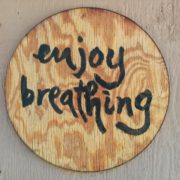Neurofeedback – Promising non-pharmaceutical intervention strategies for anxiety and depression!
Many people that I connect with express a desire to try other approaches to address symptoms of anxiety and depression before turning to medications, especially when it is their children that are suffering from such symptoms, as all prescription medications come with undesired side-effects. As a psychotherapist and yoga teacher, I share the research with them that shows the effectiveness of integrating these two (yoga and talk therapy) healing arts to support the shift in focus toward health promotion for those who prefer to take a more natural, holistic approach to healing. Now I am excited to share recent research that demonstrates combining neurofeedback with heart rate variability training (e.g., deep slow abdominal yogic breathing) provides another viable non-pharmaceutical approach to address the symptoms of anxiety and depression. And the research showed a reduction in symptoms for both children and adults!
Neurofeedback is not new and is a form of biofeedback, where instruments are attached to the body to provide information to the individual on the functioning of their body. Biofeedback, including neurofeedback, as a field of study has been growing since the 1960s. Neurofeedback (or EEG biofeedback) is the form of biofeedback that enables people to change the brain’s electrical activity. An EEG (electroencephalography) is the device that captures the real-time brain wave activity so it can be displayed and assessed for any unhealthy patterns that might be contributing to symptoms, such as anxiety and depression. Being able to offer a way to change unhealthy brain wave patterns through neurofeedback is of special interest to those of us working with clients to relieve such distressing symptoms because the brain is a central contributor to the emotions, physical symptoms, thoughts and behaviors that define many problems for which people reach out for support.
Yoga and it’s slow, controlled deep abdominal breathing is also not new. What is new is the research that is showing how this yogic breathing impacts heart rate variability (HRV). HRV has been shown to be linked with an increase in cardiovascular disease, specifically when the variability is low. (Please refer to last month’s Reflection to learn more about HRV.) Stress and anxiety increases the activity of the sympathetic nervous system, the system responsible for the flight-fight response in the body, leading to increases in heart rate and a lowering of heart rate variability. On the other hand, activation of the parasympathetic nervous system, the system responsible for the rest-digest response in the body, has been shown to decrease heart rate and increase heart rate variability, specifically through the stimulation of the vagus (Cranial X) nerve that controls the heart, lung and digestion. It is the controlled breathing found in a regular yoga practice that stimulates the vagus nerve, bringing balance to the activity of the sympathetic nervous system activity.
Even more recent research has brought these two healing modalities together to assess the impact of stimulating both the brain with neurofeedback and the vagus nerve with deep abdominal breathing on symptoms of anxiety and depressing in both children and adults. The results showed evidence that such training may provide an effective, non-pharmaceutical approach to reducing such symptoms, with some additional benefits such as improving blood pressure!
To read the full research article, click on the link below:




